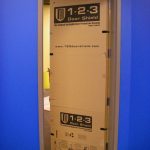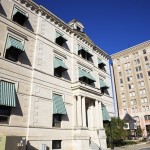 When the Robinson Center first opened its doors to the citizens of Little Rock, Arkansas in 1939, it was the largest air-conditioned auditorium in the state, with seating for up to 3,000 people. Featuring a theater, arena and several convention and lecture halls, the Robinson Center soon became the cultural center of life in Little Rock.
When the Robinson Center first opened its doors to the citizens of Little Rock, Arkansas in 1939, it was the largest air-conditioned auditorium in the state, with seating for up to 3,000 people. Featuring a theater, arena and several convention and lecture halls, the Robinson Center soon became the cultural center of life in Little Rock.
But after delighting audiences with a variety of musical and theatrical performances for more than 70 years, Little Rock city officials decided the Robinson Center was in need of a facelift. On July 1, 2014 the Robinson Center was closed so that the building could undergo an extensive renovation process that cost $70 million and took two years to complete.
Renovations included upgrades to the acoustics and audio/visual systems, an expansion of the loading dock and refinishing of the building’s iconic Art Deco style. During the course of the renovations, the Robinson Center was effectively gutted to its concrete shell so the interior could be completely rebuilt. City officials initially considered abandoning the building due to the expected cost of the renovations, but they were able to convince taxpayers to approve funding for the project with a vote in 2013. Now, four years later, it’s safe to say that the city is pleased with its decision to revive the aging building.
“This hall is not just our instrument as an orchestra, but it’s a place where Arkansans of all ages and every background can come together collectively and communally and share beautiful experiences together,” said Philip Mann, music director of the Arkansas Symphony Orchestra during the Robinson Center’s reopening ceremony.
The first performance in the newly-renovated auditorium took place in late November of 2016 when the Arkansas Symphony Orchestra took the stage for its annual Opus Ball.
At Construction Protection Systems, we’re proud to have had the opportunity to play a part, however small, in the rebirth of one of Little Rock’s oldest cultural institutions. Stay tuned for more updates from the makers of 1-2-3 Door Shield—the original, reusable door protection system.

 The Los Angeles Lakers are currently in the midst of an ambitious rebuilding effort that will not only involve changes to the team’s lineup, but to its training facilities as well. The team’s management felt that the Lakers had outgrown the recreational complex which has housed their training facilities since 1999, and this rebuilding period offered an ideal opportunity to establish a new home for the team. In late 2016, the team offered fans their first glimpse of the massive, $80 million training complex that’s currently under construction in El Segundo, California.
The Los Angeles Lakers are currently in the midst of an ambitious rebuilding effort that will not only involve changes to the team’s lineup, but to its training facilities as well. The team’s management felt that the Lakers had outgrown the recreational complex which has housed their training facilities since 1999, and this rebuilding period offered an ideal opportunity to establish a new home for the team. In late 2016, the team offered fans their first glimpse of the massive, $80 million training complex that’s currently under construction in El Segundo, California. Thanks to a $40 million bond issue approved by voters in 2015, students in the R-7 School District of Lee’s Summit, Missouri will soon have access to state-of-the-art STEM learning facilities at the Summit Technology Academy’s new Missouri Innovation Campus. The
Thanks to a $40 million bond issue approved by voters in 2015, students in the R-7 School District of Lee’s Summit, Missouri will soon have access to state-of-the-art STEM learning facilities at the Summit Technology Academy’s new Missouri Innovation Campus. The  At Baylor University in Waco, Texas, residents of Penland Hall are enjoying a host of new amenities added during an extensive $19 million remodeling effort that was
At Baylor University in Waco, Texas, residents of Penland Hall are enjoying a host of new amenities added during an extensive $19 million remodeling effort that was  The January issue of
The January issue of  By all accounts, it’s a great year to be a student at Clemson University in South Carolina. Earlier this month, the school’s football team took home a national title in a huge upset victory over the University of Alabama. This momentous win was the culmination of an intense
By all accounts, it’s a great year to be a student at Clemson University in South Carolina. Earlier this month, the school’s football team took home a national title in a huge upset victory over the University of Alabama. This momentous win was the culmination of an intense  Affectionately known as “Silicon Hills,” Austin, Texas was ranked as the
Affectionately known as “Silicon Hills,” Austin, Texas was ranked as the  US Lacrosse was formed in 1998 following a merger of eight national lacrosse organizations, most of which were run by volunteers. Since then, the organizing body of American lacrosse has made great strides in their efforts to bring the sport to a wider audience and provide young athletes with opportunities to try it for themselves.
US Lacrosse was formed in 1998 following a merger of eight national lacrosse organizations, most of which were run by volunteers. Since then, the organizing body of American lacrosse has made great strides in their efforts to bring the sport to a wider audience and provide young athletes with opportunities to try it for themselves. 87 years ago, Bowles Hall became the first residence hall on the University of California, Berkeley campus. Founded on distinctly egalitarian principles, Bowles Hall was self-governed by the students who occupied it until the mid-1970’s. Residents lived there for the duration of their undergraduate careers. They ate together, learned together, and established time-honored traditions that remain near and dear to the collective heart of the campus.
87 years ago, Bowles Hall became the first residence hall on the University of California, Berkeley campus. Founded on distinctly egalitarian principles, Bowles Hall was self-governed by the students who occupied it until the mid-1970’s. Residents lived there for the duration of their undergraduate careers. They ate together, learned together, and established time-honored traditions that remain near and dear to the collective heart of the campus. In 2003, the largest credit union in the country opened a branch office in Pensacola, Florida with
In 2003, the largest credit union in the country opened a branch office in Pensacola, Florida with
Recent Comments